- 4 Gev beam delivered to Hall C target and annoucment of the planning of the CEBAF Dedication.
FEL Proposal Reviewed By DOE by Erica Murray-Hirabayashi, Director's Office Administrator
- The experimental halls (A, B, and C) are moving on schedule toward completion.
Big, Bad, and Hot: Sam Morgan and Crew Work to Develop New High Temp Furnace by Will Conners, Director's Office Intern
Top Donor Urges All to "Give the Gift of Life"" by Will Conners, Director's Office Intern
Suggestion Program Grant's Employees Wish by Will Conners, Director's Office Intern
Wang Wins APS Award for Thesis by Will Conners, Director's Office Intern
Science Series Set for Summer Visitors
Bulls Eye!
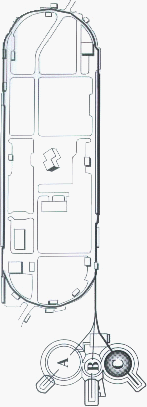 4 Gev beam delivered to Hall C target
4 Gev beam delivered to Hall C target
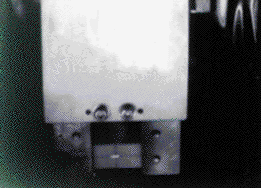 CEBAF delivered a pulsed electron beam at 4 GeV to a target in Hall C at 6 p.m. May 25, 1995. The beam traveled five times around the accelerator reaching an energy of 4-billion electron volts and was transported to a beryllium oxide target in the experimental hall. This places CEBAF on the edge of accomplishing milestone 32b-continuous wave beam at 4 GeV.
CEBAF delivered a pulsed electron beam at 4 GeV to a target in Hall C at 6 p.m. May 25, 1995. The beam traveled five times around the accelerator reaching an energy of 4-billion electron volts and was transported to a beryllium oxide target in the experimental hall. This places CEBAF on the edge of accomplishing milestone 32b-continuous wave beam at 4 GeV.
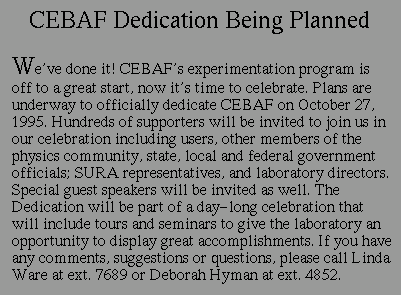
FEL Proposal Reviewed by DOE
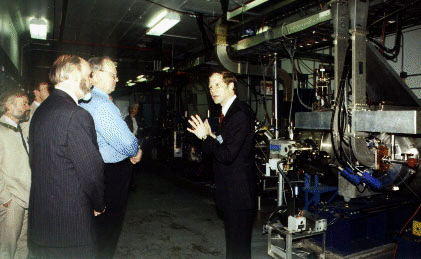 Feasibilty, validity and benfits examined
Feasibilty, validity and benfits examined
On May 10-12 the Department of Energy (DOE) sponsored a review of CEBAF's Free Electron Laser (FEL). For two days CEBAF presented the project to an expert panel selected by DOE.
DOE commissioned the review "to examine in detail the Free Electron Laser Facility proposed by CEBAF to assess its technical feasibility, the validity of associated cost estimates, and the potential benefits to industry and the government." The FEL project proposes, uses of CEBAF's superconductive radio frequency cavities to create laser light that is tunable, cost-effective, and with higher average power greater than any FEL currently in operation. The proposed FEL would be used to tailor surface characteristics of polymers, composites, ceramics and metals for use in manufactured products, thus making this project very attractive to government agencies and industries.
CEBAF's Laser Processing Consortium (LPC), formed in 1993, identified a wide range of applications to produce ultraviolet (UV) or infrared (IR) light applicable to industry. The LPC was organized by members of CEBAF's Industrial Advisory Board and several SURA universities to define and implement plans for collaborative development of cost-effective, high-average-power UV-IR FEL's for industrial processing.
The review was chaired by David Cheney, DOE Associate Deputy Under Secretary for Technology Partnerships. Other reviewers chosen by DOE because of their expertise in lasers included: Paul Houston of Cornell University, William Colson, Naval Postgraduate School, Erik Johnson of Brookhaven National Laboratory, Thomas Theis of the IBM Thomas J. Watson Research Center, Jerry Nolen, Jr. of Argonne National Laboratory, Michael McLaughlin of General Electric CRD, and David Glocker, Eastman Kodak Company.
Michael Kelly, Dupont Senior Scientist, and Fred Dylla, CEBAF's FEL Program Manager,began the review on May 11 with an overview of the FEL program. Henry Helvajian of the Aerospace Corporation, Leonard Brillson, Chief Technical Officer at Xerox, and Daniel Henkel, Senior Research Scientist/Group Leader at NASA Langley Research Center focused their presentations on industry applications for the FEL. CEBAF staff played major roles in the review. George Neil, Deputy FEL Program Manager presented the UV FEL project as a whole while Beverly Hartline, Associate Director, focused on project management. Stephen Benson, staff scientist, Charlie Sinclair, Operations staff scientist and David Neuffer, contributed information regarding facility design, while Michelle Shinn focused her presentation on the FEL system. Mark Wiseman also contributed by submitting a paper on the various components of the accelerator.
At the close of the session, reviewers were asked to submit summaries of their views on the project., with very specific questions in mind. The questions included:
- Were the concepts technically sound?
- Does the project fit with missions of various DOE programs?
- Is there a conflict with the laboratory's primary mission?
- How ready is the projected value of products to process that this [FEL project] would enable?
CEBAF eagerly awaits the results of the review.
Erica Murray-Hirabayashi, Director's Office Administrator
Update
Experimental Halls
The experimental halls are moving on schedule toward completion. While Hall C is ready for research, Halls A and B are gearing up for their debut in fiscal year 1996. Following is a brief update:
Hall A
Following the assembly and installation of the support cradles for the two spectrometers in the experimental hall, the superconducting dipole magnets for each are now in place. Weighing approximately 500 tons each, positioning and installing these "bending" magnets was a complex undertaking.
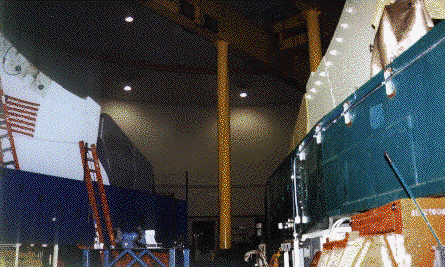
The hadron and electron dipoles have been installed in Hall A.
The second and final quadrupole magnets (Q1) manufactured by Saclay have been tested and accepted; currently, it is being mapped. The second set of Siemens' quadrupole magnets (Q2 and Q3) were also tested and accepted, completing all magnet testing and acceptance with the exception of the hadron dipole.
Hall B
The first set of components for the Cerenkov counters were received from the Rensselaer Polytechnic Institute, Troy, N.Y., collaboration. Members of the collaboration will assemble the detectors this summer in the Test Lab. The cosmic ray test stand in the Test Lab is complete and is being used for the time-of-flight scintillators. It will also be used for testing the electromagnetic calorimeters.
The Carnegie-Mellon and University of Pittsburgh collaboration has delivered a prototype drift chamber for Hall B. It is being installed to confirm that its design meets size specifications. It will fit within a space in Hall B's superconducting magnet. The design of the drift chamber is unique in that it uses less external structure to support it than previous designs. Instead, the Hall B drift chamber relies on a system of rods and wires to maintain proper tension and structure of the unit. The permanent drift chamber is currently under fabrication and will be ready for installation next summer.
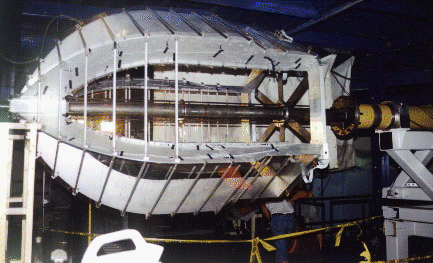
The prototype drift chamber for Hall B is being installed to confirm specifications.
The Old Dominion University collaboration is stringing the prototype Region II drift chamber at the school. They have already assembled the first Region III box.
Hall C
The Short Orbit Spectrometer has been partially commissioned and cabling is complete. The doors for the detector hut are in place.
The High Momentum Spectrometer is undergoing a final level of commissioning. It is operationally capable of doing physics.
Decisions have been made on the schedule of experiments. The first will be led by Roy Holt of the University of Illinois. Scheduled for September, the experiment will test Deuteron Photo-Disintegration.
The last piece of basic equipment, the cryogenic target system, will be installed in July.
Big, Bad, and Hot
Sam Morgan and crew work to develop new high temp furnace
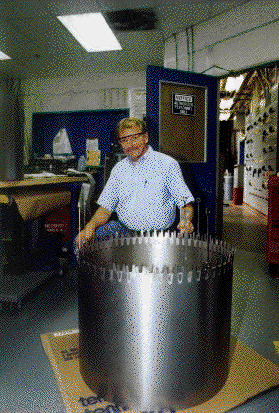 "I love it when they [pessimists] tell us we can't do something, it just makes me want to do it that much more," says Sam Morgan of the pair parts Machine Shop in the Test Lab. From machining pair parts for the accelerator to the current fabrication of a high-temperature vacuum furnace, Morgan has consistently strived to rise to the challenge of surmounting obstacles to satisfy project objectives. One such project is the development of a high temperature vacuum furnace.
"I love it when they [pessimists] tell us we can't do something, it just makes me want to do it that much more," says Sam Morgan of the pair parts Machine Shop in the Test Lab. From machining pair parts for the accelerator to the current fabrication of a high-temperature vacuum furnace, Morgan has consistently strived to rise to the challenge of surmounting obstacles to satisfy project objectives. One such project is the development of a high temperature vacuum furnace.
The furnace will be one of the largest of its kind in the world. Its operating temperature of 1600 degrees Celsius will "bake" impurities, such as hydrogen, out of superconducting niobium cavities. The furnace was designed by engineer, Joe Susta. Team members Frank Folson, John Brawley, Jody Brock, Richard Brown, and Bob Bennett were also indispensable to the project.
Morgan says that the furnace will be bigger and deliver more heat and vacuum pressure than comparable furnaces. Average operating levels for vacuum furnaces (measured in values of torr) are 10-5 torr. The furnace is designed to operate at 10-8 torr, which is considered an exceptional vacuum power. Currently, cavities are chemically cleaned, while in the near future, cavities will be chemically treated and then placed in the furnace to remove any existing impurities. The net gain will be cavities which are cleaner and more efficient.
Upon joining the lab, Morgan's primary duty was fabricating niobium pair parts for the accelerator. "Back then, none of the contractors wanted to touch niobium," says Morgan. "The ones that were willing to work with it were so expensive that we decided to do most of the work using in-house talent." Part of the initial challenge with many applications and techniques for working with niobium were so new that definitive sources of authority on the subject were sometimes non-existent. "A lot of it wasn't in the book, and we improved on what was in the book," he says. In all, Morgan estimates 15-20,000 of the accelerator's parts were machined in his machine shop.
Morgan's interest in fabrication developed at an early age. "My father worked at NASA when I was a boy, and he truly was my inspiration," says Morgan. At ten, his first project was the construction of a go-cart. His boyhood interest led him to seek training in fabrication and design. He received technical training at Virginia Occupational Technical Institute (VOTECH) where he mastered machine shop, sheet metal, and drafting skills.
Morgan's initial experience was in air conditioning and heating fabrication. Morgan continued to pursue additional training with the ambition of working in technical fabrication. Before joining CEBAF, this path lead him to a private firm specializing in vacuum instruments. Morgan says of his work in fabrication, " Building things is like a garden, you work on it part-by-part and watch it grow into something whole." The current high temperature vacuum furnace project is but one example of an opportunitity Morgan has had to apply his skill and knowledge at CEBAF.
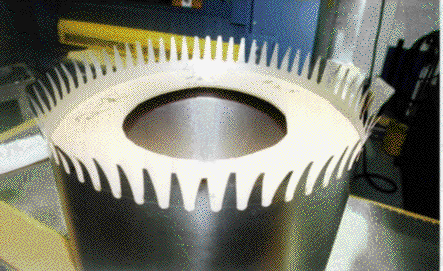
Extending from the top of each niobium insert are a series of notches which are bent over to seperate inserts together.
For the furnace's fabrication, Morgan used sheets of niobium 10,000th of an inch thick to construct a series of inserts. Extending from the top of each insert is a series of "teeth" or notches. He painstakingly measured and cut each sheet by hand. Due to the expense of niobium, Morgan says he took precautions to guard against cutting errors. "I measured once, twice, three times, and then took a break. Then I measured one more time before making my cut," says Morgan. After cutting, the ends of each sheet were joined together and spot welded to construct a cylindrical-like shape. The inserts were then sent to Brawley who operates CEBAF's electron welder. Brawley put the inserts into the welder for seam welding of flawless quality. The notches are bent over to secure the sheets together.
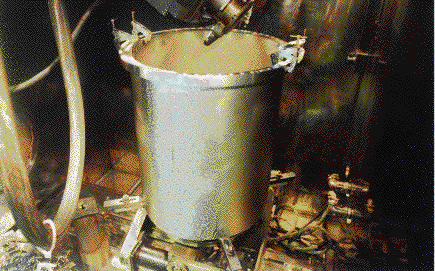
Welds of flawless quality are made on the inserts by CEBAF's computerized electron beam welder.
Ultimately, like a collapsible telescope, the inserts of differing sizes will fit into one another, building vertically. Each cylindrical insert will fit into the furnace's outer shell which is made of stainless steel and resembles a huge water heater. Bennett is developing an inner chamber water chiller which will cool the furnace. Many of the parts which Morgan could not fabricate by hand were cut on a computerized milling machine operated by Folson, of the team.
After processing in the clean room, the inserts are assembled. When completed, the furnace will be placed in a space below floor level in the R&D Clean Room located in the Test Lab.
Morgan credits the expertise and talent of his team members for the group's accomplishments. While conducting a mini-tour of the production process, it became clear that Morgan's enthusiasm for his work extends far beyond any particular project. He would preface the entry of another team member's work area with effusive praise for that member's experience and skill. "The people and talent we have here are amazing. We all help each other; if I have a problem, there is always someone who can help me solve it," says Morgan.
While Morgan continually points to teamwork as a determining factor for success, his enthusiasm has played a great part as well. Morgan's outlook on CEBAF and his co-workers is best summed up by Morgan himself when he says, "Some people talk about how great it would be to win the lottery. Heck, by working at this place, with the people I work with; I feel like I have won the lottery."
Will Conners, Director's Office Intern
Picnic Perfect
Food, fun, and sun at Newport News Park
Perfect picnics are hard to come by, but the CEBAF 1995 Family Picnic on May 13th came close. Hot, sunny weather, lots of tasty food, fun children's activities, and plenty of good company made for a most enjoyable day. The grills were lit early that morning and burned most of the day with dedicated staff members at the helm. A moonwalk, traveling entertainer, face painting, streamer sticks, free popcorn, snow cones and cotton candy added to the festivities. There was also some competition on the volleyball court and softball field. And of course, a CEBAF News photographer caught it all on film.

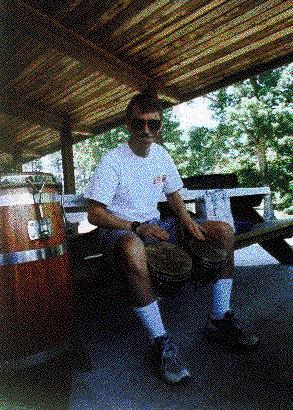
The festive sounds of the bongo drums, played by George Neil (Accelerator), kept picnickers entertained throughout the event.

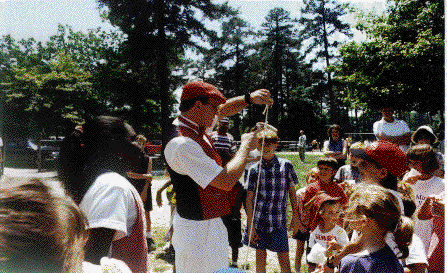
Children's activities were abundant with the moonwalk, face painting, and a traveling entertainer to keep them busy.

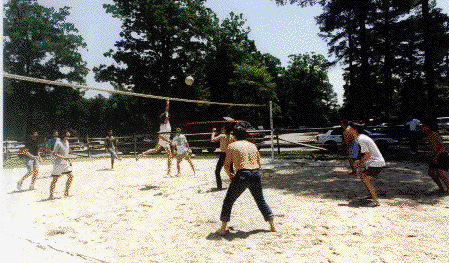
What picnic would be complete without volleyball? Randy Wojcik (Physics) is ready to spike the ball during this heated match.
And the Fun Continues...
Road Trip!
The Employee Recreation Committee has planned a one day whirlwind trip to Atlantic City on Saturday, July 22. The bus will leave CEBAF at 6:45 a.m. and return the following morning at the same time. The cost is $40 per person. Participants will receive $10-$15 in casino tokens upon arrival.
Don't wait until the last minute to reserve your spot on the bus. Reservations are being accepted by Staff Services until June 23. For more information, contact Walter Lacy at ext. 6246.
Family fun at Kings Dominion
It's CEBAF Day at Kings Dominion and everyone's invited. Don't miss a day of fun, sun and thrills on August 19 at the discounted price of $17.95 per person. Kings Dominion boasts a large waterpark, Nickelodeon theme park, and more for children of all ages. Play all day, then watch the fireworks beginning at 10 p.m. Reserve your tickets at Staff Services. Transportation is not included. For more information, contact Eric Woodworth at ext. 7217.
Bowling Season Scores

The final standings for the CEBAF Bowling League are as follows: 1st place team Geno Godwin, Roosevelt Banks, Christine Woodworth, Eric Woodworth. 2nd place team Theresa Danforth, Harry Danforth, Jason Ceraul, Linda Ceraul 3rd place team Liette Bohler, John Price, Mike Zarecky, Dick Brown High Average Male Female Jason Ceraul, 192 Angie Smith, 157 Eric Woodworth,179 Christine Woodworth,156 Tony Lapolla, 172 Sabrina Bryant, 139 High Scratch Game Male Female Steve Smith, 266 Christine Woodworth, 225 Jason Ceraul, 257 Michelle Brisiel, 210 Allen Morris, 251 Angie Smith, 201 High Scratch Series Male Female Jason Ceraul, 671 Michelle Brisiel, 551 Eric Woodworth, 619 Christine Woodworth, 535 Steve Smith, 615 Angie Smith, 510 High Handicap Game Male Female Allen Morris, 317 Michelle Brisiel, 270 Steve Smith, 302 Donna "Dancin" Lewis, 266 Harry Danforth, 301 Estelle Seeley, 266 High Handicap Series Male Female Tony Lapolla, 737 Michelle Brisiel, 731 Walter Lacy, 728 Katie Bestwick, 681 Allen Morris, 724 Liette Bohler, 679 Most Improved Roosevelt Banks Liette Bohler
Briefly...
Summer program in need of mentors
The CEBAF Summer Institute for Teacher Enhancement, or SITE, program is in need of mentors to host participants. Mentors must present a reasonable project that would offer the participant the most experience in their field.
The program, which runs July 9 to August 4, hosts four or five teachers to each project which must be relevant to CEBAF, as well as incorporate aspects of the scientific process. Projects should be contained enough to reach a conclusion in four weeks. The teachers are available to work on the projects during the afternoon hours.
For more information, please contact Mark Wissmann at ext. 7319, or Bill Williams at ext. 7128.
Two new publications containing interesting facts on CEBAF are available.
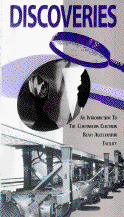
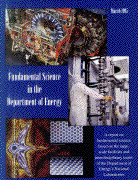
A slick CEBAF brochure called, Discoveries: An Introduction to the Continuous Electron Beam Accelerator Facility, captures CEBAF's mission in a creative manner for readers of all ages. Using eye-catching graphics and highlighted phrases, the new brochure is a easy to read. Receive a copy in the Director's Office, or by calling ext. 7689.
Also available, is a booklet created to highlight the fundamental science being performed by Department of Energy laboratories. A summary, as well as specific capabilities of each laboratory is highlighted throughout the report called, Fundamental Science in the Department of Energy.
Based on the large-scale facilities and interdisciplinary teams of the DOE National Laboratories, the report was prepared as part of the activities of the Department of Energy-National Science and Technology Council Laboratory Coordinating Committee. It was written and editied by a group of scientiest representing each of the DOE National Laboratories with major programs in fundamental science.
CEBAF's Nathan Isgur headed the Subcommittee on Fundamental Science which produced the report. Receive a copy in the Director's Office, or by calling ext. 4867
Top donor urges all to "give the gift of life"
Bill Smith heard the plaintive screams shattering the lazy afternoon and knew something was terribly amiss. Smith, then 16-years-old, ran to a nearby home, which was under construction, to investigate.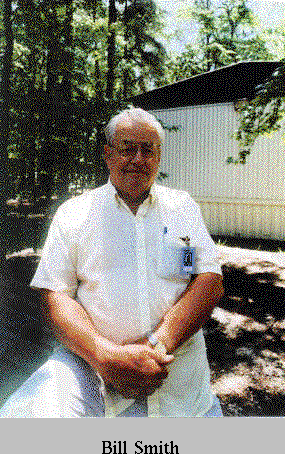
The source of the cries was a horribly injured neighborhood boy who had shredded his legs by jumping into a stack of window sashes that were stacked flat in the house. Smith acted quickly to wrap the boy's legs with shirts from a clothesline. He then transported the boy to a hospital and volunteered to donate blood if his blood type proved to be a match. That offer landed Smith on a gurney, and the doctor proceeded to transfuse blood directly from good Samaritan to victim. Fortunately, the boy's life was saved. "The gratitude of the boy's mother and father is a thing I will never forget," says Smith.
For Smith of the CEBAF Instrumentation and Controls Department, and those who have been saved by Smith's donated blood, the saying "giving the gift of life" is more than just another slogan. During the last CEBAF blood drive, Smith was informed that he had donated over 80 pints (10 gallons) of blood in a lifetime of giving. He holds the distinction of being the only CEBAF employee who is a 10 gallon donor, evidenced by the 10 gallon pin given to him by the Red Cross to recognize his contribution. He looks forward to giving again in CEBAF's July blood drive (see inset for details).
Smith says he has known many recipients of his donated blood, and has received cards from many that he did not know. "I don't feel like a hero or anything, but there is no greater day brightener than having a patient or relative, especially a mother, tell you that they think you saved a life," Smith says. After another dramatic scenario, in which Smith again donated blood, he says he really began to understand the impact that a donor can have. "I realized this [donating blood] was a really effective way to share the good fortune of being healthy and able to help folks who really needed the help I could give. I guess it is sort of sharing a renewable resource," says Smith. He has even banked blood for himself when scheduled for surgery.
While Smith realizes he has reached a milestone as a 10 gallon donor, he intends to sustain his level of commitment, and says he will continue to convey to those who have never donated before that their blood donation could mean the difference between life and death for someone in need. As Smith explains, " It's a good thing to do, it's the right thing to do. And I can't think of any act of giving or sharing which is truly needed and appreciated by so many people." Undoubtedly, there are many people who are living today because of one individual's commitment that would agree with Smith's assessment.
Will Conners, Director's Office Intern
Suggestion program grant's employees wish
Fresh food vending machine installed at MCC
Third shift site employees won't have to go hungry anymore, or settle for a snack of not so healthy chips while at work. Thanks to the CEBAF Suggestion Program and an employee suggestion, staff members will now have the opportunity to purchase a choice of fresh fruit, salads, or sandwiches twenty-four hours a day from a newly installed vending machine in the Machine Control Center (MCC).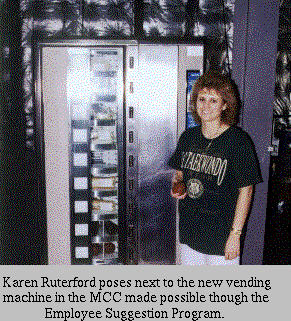
The Suggestion Program which has been up and running for four months (see "Suggestions Anyone?" February's CEBAF News), provided Karen Rutherford of the Accelerator division, with an avenue to address her concern that third shift employees did not have access to quality food for their lunch breaks. Since the cafeteria is closed during third shift, employees often had to leave the site to get food, or they had to settle for unhealthy snack food from existing vending machines.
Rutherford decided to do something about the issue by completing a CEBAF Suggestion Form. Responding to the form's questions, Rutherford identified the problem, and proposed a solution. She suggested that the addition of a vending machine that offered soup, and fresh food would improve morale and efficiency by allowing employees to stay on site and continue working. "Most people would rather have a sandwich than a candy bar for dinner" says Rutherford. Within a month of Rutherford's suggestion, a fresh food vending machine was installed in the MCC.
Bill Kozma, one of the Suggestion Program Coordinators says that the program is looking for "...not only the identification of problems, but viable solutions that can be readily evaluated and implemented." Kozma and other Suggestion Coordinators are in the process of distributing an employee survey to solicit employee input and to measure the level of satisfaction with the program.
If an employee has a suggestion, they should see their division's Suggestion Coordinator and complete a suggestion form. The suggestion is then evaluated for its merit and feasibility. Kozma says that suggestions are dealt with as expediently as possible. The suggestion program is another outlet by which employees can take proactive steps to address their concerns. All employees are encouraged to participate to make their workplace better, and more efficient. "The mark of a quality organization is when free and open communication is the everyday norm," says Kozma. The CEBAF Suggestion Program is one more step in that process.
Will Conners, Director's Office Intern
Division Suggestion Coordinators
Project Management
Leigh Ann Garza
Julie Oyer
Physics
Mike Syptak
Brian Kross
Administration
Elizabeth Lawson
Bill Rust
Accelerator
Bill Kozma
Bill Murphy
Wang wins APS award for thesis

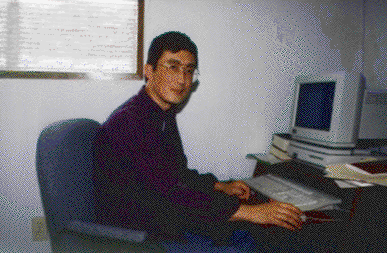
D.X. Wang
D.X. Wang of the Accelerator Performance Group has won the 1995 Physical Society's award for an "Outstanding Doctoral Thesis In Beam Physics." Wang won the award for his dissertation on high current beam theory and dynamics.
Central to Wang's research was an experimental examination of "space charge dominated" beam dynamics. This is a beam in which the force on the beam particles is predominately due to interactions between the particles, the space charge field, rather than being due to interactions with an external confining field, as represented by the more common emittance dominated beam type which is utilized in CEBAF's accelerator.
Wang chose to study space charge dominated beams for his dissertation because theories on the subject had not been extensively tested. "Space charge dominated beams are not as well studied as emittance dominated beams, I conducted experiment with it [a space charged dominant beam] to verify the theory," Wang says. Wang used a small electron beam transport channel at the University of Maryland for his experiments.
In his dissertation, Wang demonstrated how the beam evolved when its electrons were configured in various distributions. He also showed how space charged dominated beams behaved and a method to measure them. In bestowing the award on Wang, the APS stated, "He has made important advances showing how to manipulate the beam profile, and his work represents a significant achievement in beam physics research."
If fully developed, high space charge beams have a variety of exciting applications. The Free Electron Laser under development by CEBAF, will utilize a space charge dominated beam. Also, such beams are needed in heavy ion fusion, to generate fusion energy, and such beams may be used in the transmutation of nuclear waste. The transmutation process reduces the life span of nuclear waste.
Wang stresses that his dissertation and research has had a great effect on his work. "It [the research] was very important to me...I think it has given me the knowledge and ability to conduct research, which is essential."
Will Conners, Director's Office Intern
Science Series set for summer visitors
When summer comes to mind, thoughts are usually filled with visions of hot weather, cookouts, and days at the beach. However, at CEBAF, minds are focused on the CEBAF Summer Science Series. This group of lectures provides a basic overview of what happens at CEBAF. The speakers are members of the staff and experts in their fields.
According to Bill Williams, the BEAMS/Teacher Program Manager, the series is geared specifically to the teachers and student interns who work here during the summer, but he adds that the lectures are open to anyone who is interested. The lectures will be held in the CEBAF Center Auditorium every Thursday at 3:30 p.m. June 29 through August 18, 1995. Check out the adjoining list of scheduled lectures and speakers.
Series Schedule
June 29
"The CEBAF Project"
Beverly Hartline
July 6
"Quarks! Gluons! & All"
Nathan Isgur
July 13
"Accelerator Physics"
Lia Merminga
July 20
"Nuclear Physics Experiments"
Carlos Salgado
July 27
"Superconducting Technology"
Charles Reece
August 3
"Free Electron Lasers"
George Neil
August 10
"Accelerators & the Future"
Hermann Grunder

